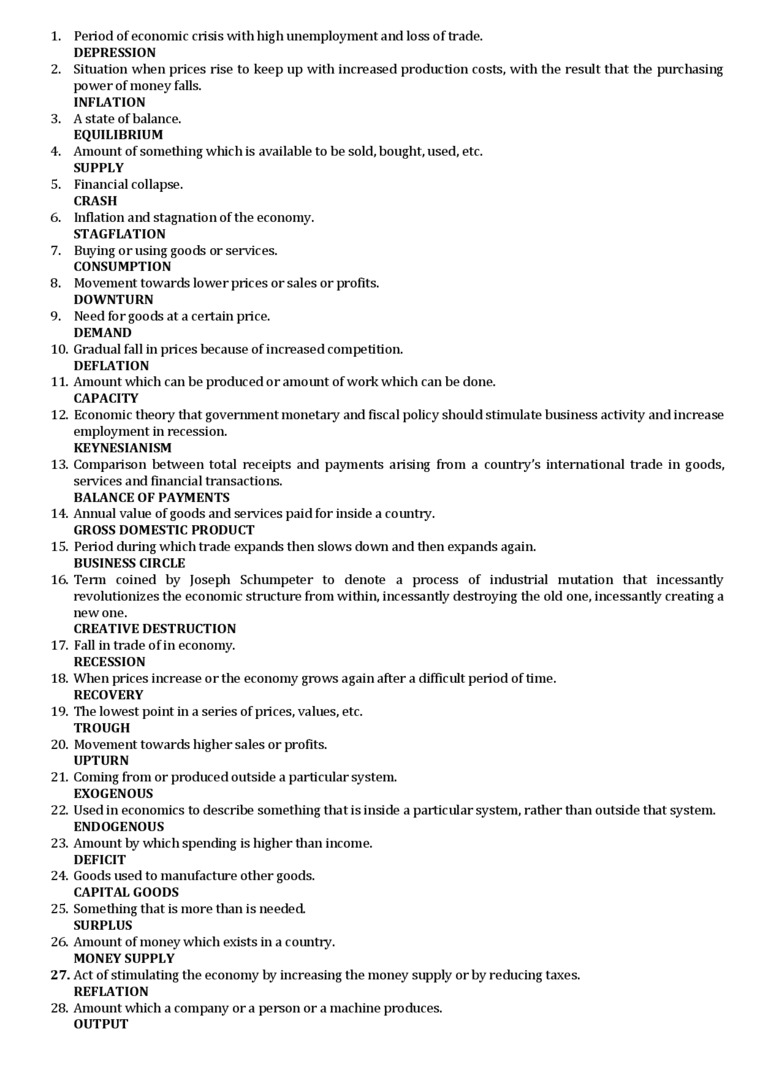33060

1. Period of economic crisis with high unemployment and loss of trade.
DEPRESSION
2. Sitnation when prices rise to keep up with increased prodnction costs, with the resnlt that the puirhasing power of money falls.
INFLATION
3. A State of balance.
EQUILIBRIUM
4. Anionnt of something włiich is available to be sold, bought, used, etc.
SUPPLY
5. Financial collapse.
CRASH
6. Inflation and stagnation of the economy.
STAGFLATION
7. Bnying orusing goods or services.
CONSUMPTION
8. Moveraent towards lower prices or sales or profits.
DOWNTURN
9. Need for goods at a certain price.
DEMAND
10. Gradual fali in prices because of increased competition.
DEFLATION
11. Amonnt which can be prodnced or amoimt of work which can be done.
CAPACITY
12. Economic theory that govenunent monet ary and flscal policy shonld stimulate business activity and increase employment in recession.
KEYNF.SIANISM
13. Comparison between total receipts and payments arising from a country's international trade in goods, semces and fmancial transactions.
BALANCE OF PAYMENTS
14. Annual value of goods and semces paid for inside a countiy.
GROSS DOMESTIC PRODUCT
15. Period during which trade expands then slows down and tlien expands again.
BUSINESS C1RCLE
16. Term coined by |oseph Schumpeter to denote a process of industrial mutation that incessantly revolutionizes the economic stmcture from within, incessantly destroying the old one, incessantly creating a newone.
CREAT1VE DESTRUCTION
17. Fali in trade of in economy.
RECESSION
18. When prices increase or the economy grows again after a difficult period of time.
RECOVERY
19. Tlie lowest point in a series of prices, valnes, etc.
TROUGH
20. Movement towards higher sales or profits.
UPTURN
21. Corning from or prodnced outside a particular system.
EXOGENOUS
22. Used in economics to describe something tliat is inside a particular system, ratłier than outside tliat system. ENDOGENOUS
23. Amount by włiich spending is higher than income.
DEFICIT
24. Goods used to manufacture other goods.
CAPITAL GOODS
25. Something that is morę tlian is needed.
SURPLUS
26. Amount of money which exists in a country.
MONEYSUPPLY
27. Act of stimuiating the economy by increasing the money supply orby reducing taxes.
REFLATION
28. Amount which a company ora person or a machinę produces.
OUTPUT
Wyszukiwarka
Podobne podstrony:
d. Normally the start and finish datę of the study period will coincide with the s
Madę of high-quality Steel galvanized, with high hardness, durability, good abrasion resistance, and
33. B.107500/2 ECONOMIC crisis and political economy : volume 2 of essays in honour of Tadeusz Kowal
Speech timing problems Associated with dysarthria often involve the presence of periods of extraneou
[ fic]?nedictus,?vid The Fourth of June SF1 with its totems and taboos, is a place for a boy wit
NEW STEREO RECEIYER no one but bogen, builder of over one million high-fidelity and sound-distr
Higher educationsystem in Poland economy; i master (MA, MSc, magister) and equivalent degrees: Maste
tional ąuestion" ought to be formulated, by contrast with the 18* and 19* century question of t
ipe 37 72 72. Make a fist with one hand and place it in the palm of ihe other
jff iv This book is dedicated with great respect and affection to: GEORGE YOSHIDA, Director of the N
kryzysy marokańskie (12) >28 CHAPTER U Art. 4: Thcse officcrs and noncommissioned officcrs Jor a
84*1697 Stabiity of FoUower-Force Rod« with Weight H.H.E. Leipholz and R. Piche Univ. of Waterloo. W
968 A. Edorh et al. tumors were associated with advanced clinical and histological markers. The esti
6. Financial standing of the Daimler AG in the Period of the Global Financial
więcej podobnych podstron